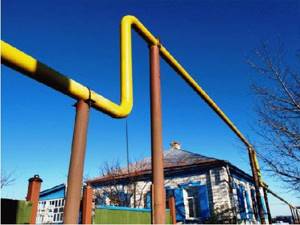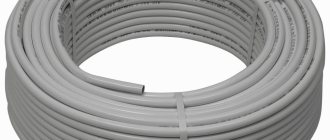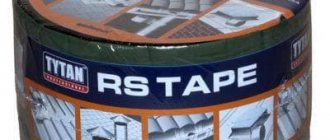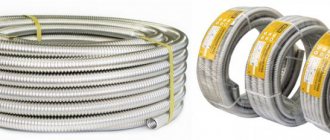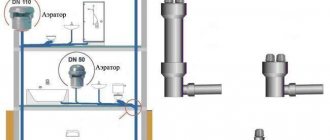Any person who builds a private house, or replaces communications in an apartment, is faced with the choice of pipes for a gas pipeline. Many people are accustomed to the fact that gas supply systems are made of metal, but in recent years plastic gas pipes have become increasingly popular. There are certain GOSTs, according to which developers can make gas pipelines from plastic.
Gas pipes made of plastic
Is it possible to use polypropylene pipes for gas?
In Western countries, metal pipes are used only for the assembly of industrial pipelines. In the manufacture of water and gas supply systems, plastic elements are used. This is due to the performance characteristics of the material. Gas flows through a plastic pipe without any difficulty. Before putting the gas pipeline into operation, it is necessary to check the tightness of the connections of individual elements in order to prevent violation of the integrity of the system.
You can figure out which is better – a pipeline made of metal or plastic – by comparing these two materials. Differences:
- Weight - plastic pipes weigh less than metal parts. Thanks to this, they are easier to install; they do not require additional fastenings on vertical surfaces.
- Versatility - There are more factors to consider when choosing metal pipes than when using plastic parts.
- Price - tubes made from polymers are cheaper than metal ones.
Metal tubes are superior to plastic ones in terms of strength, durability, and resistance to mechanical stress.
Material selection
- What types of pipes can be used when installing an external gas pipeline?
When laying above ground - only and exclusively steel pipe . The instructions are related to its strength: steel prevents accidental or intentional damage to the line.
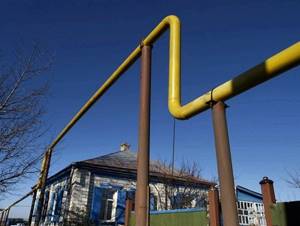
When laying externally above ground level, only steel is used.
When laying the input underground, it is permissible to use polyethylene. A polyethylene gas pipe is marked with a yellow stripe, in contrast to a water pipe with a blue marking.
- How can you install a gas pipeline inside a house?
Gas pipes in the house can be:
- Steel;
- Metal-plastic;
- Polyethylene (including cross-linked and heat-stabilized polyethylene);
- Corrugated stainless steel;
When installing a gas pipeline, a corrugated pipe in a polyethylene sheath is used. It eliminates the formation of condensation at the entrance to the house. Bare steel - black and stainless - is constantly humidified at subzero outside temperatures, since the temperature of the gas entering the house is significantly lower than the temperature in the room.
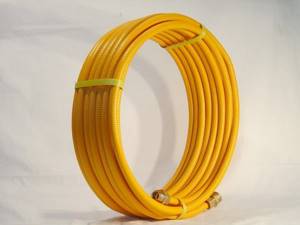
Corrugated stainless steel in a polyethylene sheath.
- Copper.
- Which connection fittings are preferable for installation?
On a steel pipe, the choice is small: only threaded fittings, brass or cast iron, are used. On gas, it is customary to use FUM tape to wind threads. In its absence, the thread can be wound:
- Plumbing flax impregnated with any quick-drying paint or silicone sealant;
- Sealing polymer thread.
On other types of pipes, maintenance-free connections , completely eliminating gas leakage:
- On copper - solder fittings or press fittings;
- The metal-plastic pipe is also equipped with press fittings;

Press fitting on metal-plastic.
- Ordinary polyethylene has to be used willy-nilly with compression fittings, but heat-stabilized PERT polyethylene is equipped with fittings for socket welding. If, of course, you come up with a strange fantasy of using it to transport a medium at room temperature and minimal excess pressure;
- The corrugated stainless steel is connected by compression fittings with silicone O-rings. Despite the ability to disassemble such a connection, it does not require maintenance and can, if necessary, be laid in a groove or screed.

To connect corrugated stainless steel, compression fittings with silicone O-rings are used.
- Can flexible hoses be used to connect a gas stove?
Yes. On sale you can find special gas hoses with stainless braiding with a yellow stripe, indicating the possibility of use specifically for gas. In addition, many times I connected the plates with reinforced high-pressure hoses designed for gas welding. The hoses were mounted on herringbone fittings and tightened with aluminum clamps for a screwdriver.

Flexible connections for connecting gas stoves.

And here a welding hose with fittings is used for connection.
Characteristics
The technical characteristics of the material determine the scope of its application. When making a gas pipeline, you can use different types of plastic pipes. Each of them has its own technical characteristics.
Metal-plastic parameters:
- High chemical resistance.
- The material is not subject to oxidation.
- The maximum coolant temperature is up to 95 degrees.
- The maximum permissible pressure is up to 25 bar. If the temperature is high, the permissible pressure is reduced to 10 bar.
- The thickness of the metal layer between the plastic is up to 0.3 mm.
Characteristics of polyethylene:
- outer diameter of tubes - 10–110 mm;
- maximum coolant temperature - up to 95 degrees;
- at high temperatures the maximum pressure is up to 10 bar.
Polypropylene parameters:
- maximum coolant temperature - 90 degrees;
- permissible pressure at maximum temperature - up to 10 bar.
Polypropylene pipes can withstand short-term overheating up to 110 degrees.
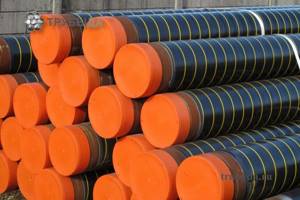
Diameter of plastic pipes
Stamps
For the manufacture of pipelines, polypropylene or polyethylene is most often used. These types of polymers are labeled by manufacturers depending on the technical characteristics.
Polyethylene marking:
- PE-80 - indicated by a yellow stripe;
- PE-100 - marked with an orange stripe.
Polypropylene marking:
- PN10 - withstand pressure up to 10 atmospheres. Suitable for the manufacture of cold water supply pipelines due to the maximum permissible temperature of 45 degrees Celsius.
- PN16 - maximum permissible pressure 16 atmospheres. The operating temperature of the coolant should not exceed 60 degrees.
- PN20 - pipes with this marking can withstand pressure up to 20 atmospheres. They are suitable for assembling heating circuits, cold and hot water supply systems.
- PN25 - products made from this material can withstand pressure up to 25 atmospheres and temperatures up to 95 degrees. They are considered the best in the manufacture of pipelines for heating and central water supply.
Additionally, the SDR parameter is indicated on polyethylene pipes. It means the relationship between the thickness of the tube walls and the diameter. The lower this parameter, the greater the wall thickness. The thicker the walls of the parts, the greater the pressure they can withstand during operation.
GOST metal-polymer products
High-quality pipe products made of metal-plastic must comply with state regulations. standard 53630-2009. The document contains the key requirements for the products in question.
They contain the following information:
The order of packaging of products. Requirements for raw materials necessary for the production of products. Products are divided into two groups according to the specified operating pressure.
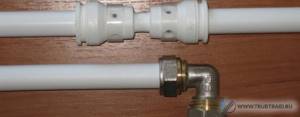
For the first category, this figure is up to 0.6 MPa, and for the second - 2.5 MPa. The maximum temperature of the carrier in a pipeline made of metal-polymer pipes is allowed up to ninety-five degrees for nine thousand hours. Product marking is established (discussed above). Depending on the diameter of the structure, they are divided into two categories. The first includes pipes ranging in size from ten to sixty-three millimeters. The second category includes products with a diameter from seventy-five to one hundred and ten millimeters. Methods for supplying products are indicated.
Pipes of the first category are delivered in lengths up to twelve and a half meters or in coils. In the latter case, the footage must be a multiple of one hundred. Products of the second category are supplied only in the form of pieces of different lengths.
If the structures comply with the specified GOST, they must have a certificate confirming this. Keep this in mind if you decide to buy pipes for installing a gas pipeline in a private house or apartment.
Kinds
Different types of plastic are used in production. Each of them has differences in technical characteristics and installation features:
- PVC. Parts made from this material are popular due to their low price, but this type of polymer has one significant drawback that narrows its scope of application. When used, this material emits chlorethylene, a toxic substance. Because of this, it cannot be used for water supply pipelines.
- Polyethylene pipes. Water supply and gas supply lines are made from them. During operation, this material does not emit harmful components, but to maintain technical characteristics, the tubes must be additionally insulated.
- Reinforced tubes. The reinforcing layer can be made of aluminum foil or fiberglass. Thanks to additional reinforcement, the scope of application of the parts is expanded.
Polypropylene pipes are also used for pipelines.
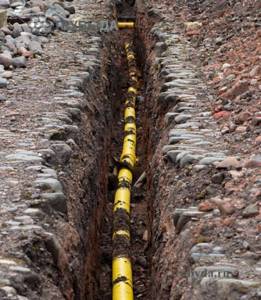
Polypropylene pipe for gas
Manufacturing technology
The production of metal-polymer pipe products is strictly regulated by the approved state standard. If technological standards are observed, metal-plastic products obtain excellent performance characteristics. They do not have the disadvantages that products made of metal have.
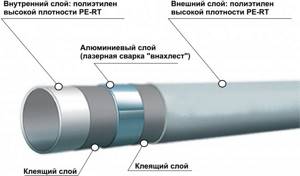
The production of metal-polymer pipes occurs in several steps:
- Using an extruder, the inner shell of the product is extruded. An aluminum layer is glued to the outer part of the resulting shell, welded with a laser overlapping or end-to-end. An outer shell is applied on top of the foil. The resulting layered structure is pressed.
The outer polymer layer helps protect the metal from exposure to water and air. Aluminum gives the product strength and rigidity. In this case, the inner layer serves as protection against the appearance of condensation and the destructive influence of the pipeline carrier.
Advantages and disadvantages
Advantages:
- Resistant to long-term gas exposure.
- The service life is about 100 years, if the pipeline is not overloaded.
- High level of flexibility. Thanks to this, it is possible to manufacture highways of complex configurations.
- Low weight of individual elements.
- No sediment accumulates on the smooth walls of the product.
- The material is not susceptible to rust.
Flaws:
- Not resistant to high temperatures.
- Plastic pipelines cannot be installed outdoors, as the material loses its technical characteristics in the cold.
- When heated strongly, the material expands. Because of this, to increase the strength of connections, individual sections of the pipeline need to install compensators.
- Low resistance to ultraviolet rays.
If you do not overload the pipeline, it will not break down and will withstand decades of active use.
Metal polymer VS metal
The use of the technology described above makes it possible to give the product good physical and mechanical properties. It is thanks to them that metal-plastic pipes are in many ways superior to their metal counterparts.
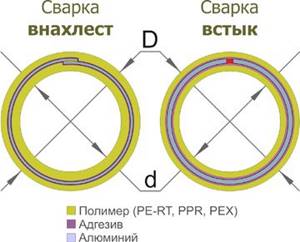
They are characterized by:
- high throughput; resistance to the appearance of internal deposits; ability to retain its shape after bending; easy installation; excellent heat resistance; resistance to corrosive processes and aggressive environments.
Installation
When installing plastic gas pipes, you need to take into account a number of nuances:
- Due to thermal expansion, it is necessary to accurately select the location for installing expansion joints.
- Avoid many bends and joints of individual elements.
- Lay pipes away from sources of open flame.
- If you need to lay a pipeline underground, it is advisable to provide additional insulation. To do this, you can use a concrete channel or an additional plastic pipe.
- When dismantling the old system, it is necessary to make the main line from one material. This will allow you to achieve high strength and maximum service life.
- It is advisable to remove the pipes from open areas due to the low resistance of the material to mechanical stress.
- Fastenings to the pipeline on vertical surfaces should be installed no further than 2 meters from each other.
To create airtight connections, you need to use a special soldering iron. It comes with nozzles of different diameters, onto which pipes, couplings, and shut-off valves are placed. After heating, the parts are joined together. All you have to do is wait for the plastic to cool and perform a test run of the system. During the inspection, you need to carefully inspect the junctions of individual pipeline elements for leaks.
People are accustomed to seeing that gas pipelines are made of metal, but this material is gradually giving way to plastic. Polyethylene and polypropylene pipes are slightly inferior to metal in terms of technical characteristics, but are cheaper.
What is the order in which a gas pipeline is laid?
Design part. Under no circumstances should you draw up a project that takes into account all the materials and parameters of the future gas pipeline yourself. In this case, the document will simply not be recognized and everything will have to be redone. It is best to entrust this operation to professionals who have the necessary experience. Most often, these are specialists from the company that will subsequently install the gas pipeline. In this case, you can also get a very significant discount.
Installation of riser and laying of pipes. A gas riser means a hole in which a casing is installed, through which the pipe passes into the house. The riser must be created at a distance of 15 centimeters from the wall in a vertical position. As for the pipeline directly in the house, it is laid with the aim of using as few joints and welds as possible. The diameter of the pipes determines whether they will be fixed with hooks or brackets, but in any case the fixation should be as reliable as possible.
Interesting! Methane itself has neither color nor odor. For this reason, in the event of a leak, we simply would not be able to detect it in the air. Especially for this purpose, at gas distribution stations it is odorized - it is given a smell. This is usually done by adding ethanethiol. Its recognizable smell will be available for identification even if we are talking about a negligible concentration of 1 part in 10 million.
